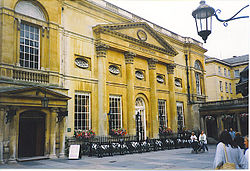"The life of a stage coach horse during the Regency era was not easy. Roads, though much improved over previous centuries, could be filled with mud and ruts that impeded progress. Generally one horse could pull a wheeled vehicle six times its own weight. Therefore, a carriage horse weighing from 1200 lbs to 2300 lbs is able to pull from 7200 lbs to 13,800 lbs. Multiply this number by four or six, and you have team that can pull a substantially sized vehicle. However, tired horses had to be replaced about every ten miles or so, and “the average life of a horse pulling a coach at about eight mile per hour was six years; at ten miles per hour or over, possible on good roads, a horse lasted three years" (The Prince of Pleasure, J.B. Priestley, 151-152).

 The Grand Pump-Room at Bath was considered a social meeting place for the upper class (Grand Pump Room, Bath, wiki).
The Grand Pump-Room at Bath was considered a social meeting place for the upper class (Grand Pump Room, Bath, wiki). "This point of the Cherwell has been used for crossing since ancient times. The first known reference to a bridge goes back to 1004 and originally it was probably a wooden trestle construction or a drawbridge. By the 16th century a late medieval stone bridge had replaced the wooden one. This bridge was about 1,500 feet (460 m) long and was formed by 20 arches.
By the 1770s, the stone bridge was too narrow for the increasing traffic, as it did not allow two vehicles crossing safely. In addition to this, the structure was becoming unsound due to the combination of two factors: a generalized lack of maintenance and the negative effects of regular flooding. Eventually some of the arches of the western side collapsed during the floods of February 1772, making the bridge irreparable" (Magdalen Bridge, wiki).
"This point of the Cherwell has been used for crossing since ancient times. The first known reference to a bridge goes back to 1004 and originally it was probably a wooden trestle construction or a drawbridge. By the 16th century a late medieval stone bridge had replaced the wooden one. This bridge was about 1,500 feet (460 m) long and was formed by 20 arches.
By the 1770s, the stone bridge was too narrow for the increasing traffic, as it did not allow two vehicles crossing safely. In addition to this, the structure was becoming unsound due to the combination of two factors: a generalized lack of maintenance and the negative effects of regular flooding. Eventually some of the arches of the western side collapsed during the floods of February 1772, making the bridge irreparable" (Magdalen Bridge, wiki). “Emily [the main character of Radcliffe’s Udolpho] has heard rumors of ghosts and mysterious tales about the Castle. She goes into a room and finds something hidden beneath a black veil. What she sees is so frightful that she will not go near the room again. There is a rumour that the Count was married to the former owner of the Castle, Signora Laurentini di Udolpho, and Emily believes that he has killed her and it is her body that lies under the black veil… Clearly not the body of Signora Laurentini di Udolpho as Emily thought, as she turned out to be Sister Agnes. What Emily saw behind the veil was a human figure, partly decayed, but the figure was not real but made of wax. It had been made as a rather gruesome penance for the Marquis of Udolpho, that he should look upon it for a certain time each day in order to receive pardon for his sins” (Knowles).
“Emily [the main character of Radcliffe’s Udolpho] has heard rumors of ghosts and mysterious tales about the Castle. She goes into a room and finds something hidden beneath a black veil. What she sees is so frightful that she will not go near the room again. There is a rumour that the Count was married to the former owner of the Castle, Signora Laurentini di Udolpho, and Emily believes that he has killed her and it is her body that lies under the black veil… Clearly not the body of Signora Laurentini di Udolpho as Emily thought, as she turned out to be Sister Agnes. What Emily saw behind the veil was a human figure, partly decayed, but the figure was not real but made of wax. It had been made as a rather gruesome penance for the Marquis of Udolpho, that he should look upon it for a certain time each day in order to receive pardon for his sins” (Knowles).